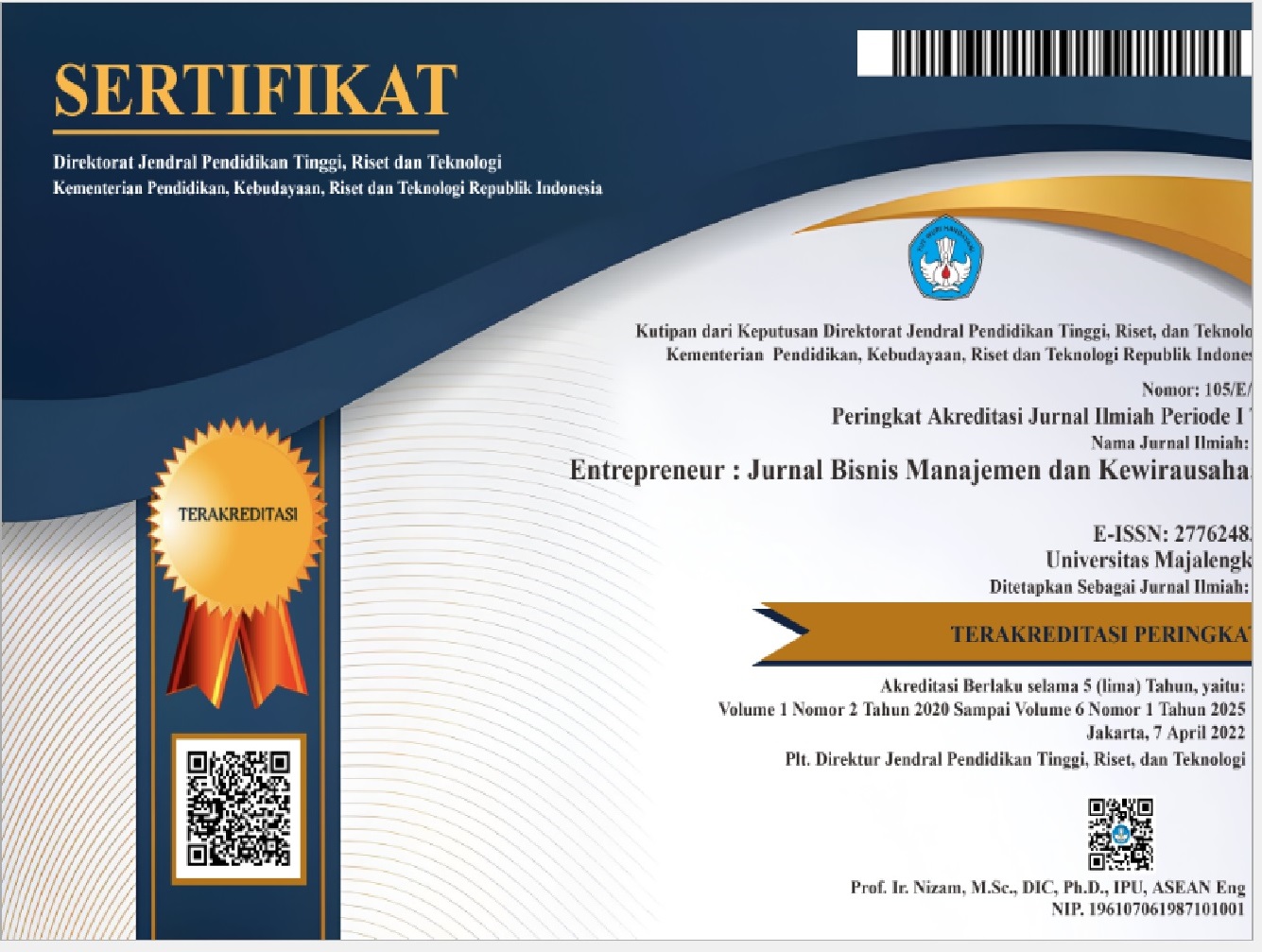TASLAMPOT (Tanaman Hias Dalam Pot) Pembudidayaan Tanaman Hias Dimasa Pandemi Covid 19
DOI:
https://doi.org/10.31949/entrepreneur.v3i1.1252Abstrak
Kebutuhan akan tanaman hias mengalami peningkatan. Selain kesan segar, keberadaan tanaman hias bisa menyehatkan tubuh karena tanaman yang ada mengeluarkan oksigen yang diperlukan manusia. Tanaman hias berperan menghasilkan oksigen dan menghiasi rumah atau pekarangan tempat tinggal kita, akan tetapi berkhasiat obat untuk kesehatan tubuh manusia. Taslampot dapat menggunakan tempat berupa pot plastik dan pot tanah liat. Media tanam taslampot tentunya memiliki kelebihan dan kekurangan. Kelebihan taslampot, yaitu praktis, tidak memerlukan banyak media dan harga relatif murah. Kelemahannya, yaitu jumlah dan jenis tanaman hias yang dapat ditampung terbatas. Taslampot dapat dijadikan solusi praktis dalam keterbatasan lahan pertanian. Keterbatasan lahan tidak menghentikan niat seseorang untuk bercocok tanam. Sebagian ibu rumah tangga tetap melakukan hobi berkebun walaupun ruang yang tersedia tidak cukup luas.
Kata Kunci:
Ornamental Plants, Practical, FarmingUnduhan
Referensi
Ahmadi, N. K., & Herlina. (2017). Analisis Segmentasi Terhadap Keputusan Pembelian Produk Eiger di Bandar Lampung. Jurnal Manajemen Magister, Vol 03. No.01, Januari 2017, 03(01), 75–95.
Akuntansi, J., Madani, M., & Gazali, S. (2017). Analisis pengaruh bauran pemasaran jasa terhadap keputusan mahasiswa dalam memilih sekolah tinggi ilmu ekonomi madani balikpapan. 1(3), 83–95.
Frandy, Y. H. E. (2019). TANAMAN HIAS BERKHASIAT OBAT. Diambil dari https://books.google.co.id/books?id=CkgTEAAAQBAJ
Hanoum, F. C. (2021). Reslaj : Religion Education Social Laa Roiba Journal Kontribusi Persewaan Tanaman Hias terhadap Pendapatan Produsen Tanaman Hias di Kota Malang dan Sekitarnya Reslaj : Religion Education Social Laa Roiba Journal. 3, 24–30. https://doi.org/10.47476/reslaj.v3i1.252
Mattjik, N. A., & Purwito, A. (2018). Budi Daya Bunga Potong dan Tanaman Hias. Diambil dari https://books.google.co.id/books?id=%5C_LoREAAAQBAJ
Ismail, A. Y., Andayani, S. A., Chovyan, I., & Wahyudin, A. (2021). Land Change Patterns for Predicting Sustainable Agriculture Development. MIMBAR: Jurnal Sosial dan Pembangunan, 37(2), 509-515.
Andayani, S. A., Sukmawani, R., Marina, I., Sulaksana, J., Rahman, U. I. L., Sumekar, Y., ... & Dani, U. (2021). Prediction model of production patterns of shallot development in the highlands of Indonesia. Research on Crops, 22(4), 895-900.
Ismail, A. Y., Aminudin, S., Andayani, S. A., & Sumekar, Y. (2021). Analysis of land use patterns in the upper Cimanuk river basin and its relationship with irrigation water discharge in Majalengka Regency, Indonesia. Research on Crops, 22(4), 836-840.
Hernita, N., & Ginanjar, Y. (2021, April). Managerial Aspect and Digital Marketing of Micro, Small and Medium Enterprises in West Java. In IOP Conference Series: Earth and Environmental Science (Vol. 748, No. 1, p. 012035). IOP Publishing.
Hernita, N., Prihartini, E., & Rahmayani, M. W. (2021). Increasing Income of Micro, Small and Medium Enterprises through Managerial and Digital Marketing Aspect in West Java. Budapest International Research and Critics Institute-Journal (BIRCI-Journal), 4(4), 10593-10600.
Andayani, S. A., Sukmawani, R., Marina, I., Sulaksana, J., Rahman, U. I. L., Sumekar, Y., ... & Dani, U. (2021). Prediction model of production patterns of shallot development in the highlands of Indonesia. Research on Crops, 22(4), 895-900.
Nahdi, D. S., Araniri, N., Jatisunda, M. G., Kurino, Y. D., & Cahyaningsih, U. (2021). Statistical Literacy of Pre-Service Islamic Religious Education Teachers. Jurnal Cendekia: Jurnal Pendidikan Matematika, 5(2), 900-908.
Syamsuddin, A. (2021). Islamic Acculturation and Local Culture on Nyiramkeun Tradition in Talagawetan Village Majalengka Regency. Budapest International Research and Critics Institute-Journal (BIRCI-Journal), 4(2), 2447-2456.
Amin, M. A. S. (2020). Communication Activities in Mitoni Events in Layansari Village (Study of Communication Ethnography Regarding Communication Activities at the Mitoni Event in Layansari Village, Gandrungmangu District, Cilacap Regency in requesting the safety of Mother and Child). Budapest International Research and Critics Institute-Journal (BIRCI-Journal), 3(2), 1289-1296.
Redjeki, F., Fauzi, H., & Priadana, S. (2021). Implementation of appropriate marketing and sales strategies in improving company performance and profits. International Journal of Science and Society, 3(2), 31-38.
Fauzi, H. (2021). THE INFLUENCE OF WORK DISCIPLINE AND INDIVIDUAL CHARACTERISTICS ON TOTAL QUALITY MANAGEMENT (STUDY AT PT. SINJARAGA SANTIKA SPORT MAJALENGKA. International Journal of Economics, Business and Accounting Research (IJEBAR), 5(3), 2105-2114.
Mulyani, H. S., Sudirno, D., & Hakim, A. (2021, April). Driving Factors For Local Government Self-Financing Ability. In IOP Conference Series: Earth and Environmental Science (Vol. 748, No. 1, p. 012028). IOP Publishing.
Supriati, Y., & Siregar, F. D. (2015). Bertanam Tomat di Pot (Edisi Revisi). Diambil dari https://books.google.co.id/books?id=xIDsCgAAQ
Diterbitkan
Cara Mengutip
Terbitan
Bagian
Lisensi
Hak Cipta (c) 2022 Ragil Anisa Prihandini, Afif Kurniawan, Risal Dwi Putra, Okida Putra Tampubolon, Karlstaine Baginda Soaloon Siregar, Abdul Rahman Kadafi

Artikel ini berlisensiCreative Commons Attribution-ShareAlike 4.0 International License.
COPYRIGHT NOTICE
An author who publishes in the Entrepreneur: Jurnal Bisnis Manajemen dan Kewirausahaan agrees to the following terms:
1. Author retains the copyright and grants the journal the right of first publication of the work simultaneously licensed under the Creative Commons Attribution-ShareAlike 4.0 License that allows others to share the work with an acknowledgment of the work's authorship and initial publication in this journal
2. The author is able to enter into separate, additional contractual arrangements for the non-exclusive distribution of the journal's published version of the work (e.g., post it to an institutional repository or publish it in a book) with the acknowledgment of its initial publication in this journal.
3. The author is permitted and encouraged to post his/her work online (e.g., in institutional repositories or on their website) prior to and during the submission process, as it can lead to productive exchanges, as well as earlier and greater citation of the published work








